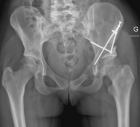Abstract
Short Communication
Contemporary learning or E-Learning in physiotherapy, pre and post COVID-19: Short communication
Mohammed Suhail*, Sharath C and Akhil Mathew
Published: 18 May, 2020 | Volume 4 - Issue 1 | Pages: 009-010
Since December 2019, an outbreak of novel corona virus disease was reported in Wuhan, which has subsequently affected more than 160 countries worldwide. The ongoing outbreak has been declared as a pandemic by WHO, a global public health emergency. Several countries are successfully fighting with the pandemic by taking strict measures like nationwide lockdown or by sequestering the areas that were suspected of having risk of community spread. The corona virus pandemic has upended our educational system worldwide [1-3].
The academic calendar all over the world has been disturbed as a result of lockdown. Even after lockdown it would take probably many more months for universities, colleges and schools to reinstate. Caught in the turmoil, some parts of urban Indian education system have turned towards delivery of education via internet or online education. The NCAER skills report 2018 discussed the immense potential of online learning, conversely as complementary to more traditional methods. Centuries old, lecture based approaches, institutional biases, and outmoded classrooms changed. Covid 19 has become an impetus for educational institutions worldwide to search for innovative solutions in a relatively short duration. In the prevailing situation, online education is turning out as an alternative to traditional modes [2,4,5].
Contemporary/E-learning prepares students across all curriculum and learning stages with skills and potential to flourish in a rapidly changing and interlinked world. It connects students and engages their sense of inquisitiveness. E-teachers know and understand the needs and talents of their students. They are trained, flexible and select from a wide range of effective teaching strategies based on need. The new learning environment and resources galvanize students to be leaders of their independent learning. Thus students collaborate and use critical and creative thinking to solve complex problems and become apprehensive and sentient global citizens [4-6]. In physiotherapy, apart from traditional institution based learning, there implies a need for technological inputs and E-learning as a need to develop critical, creative thinking and reasoning. These technological arrays do provide better concepts and understanding regarding academics and practice [6]. As physiotherapy is advancing and growing in academics, research and practice, the need for an interlinking platform through which learning becomes unconditional and globally accessible was never addressed. Covid- 19 lockdown and strategies imposed us to think apart from institutional mode, ostensibly got a worldwide acceptance.
Research suggests that online learning has been shown to increase retention of information, and take less time. On average, students retain 25% - 60% more information when learning online compared to only 8% - 10% in a classroom. E-learning requires 40-60% less time to learn and understand than in a traditional setting, because students can learn at their own pace, re-reading, skipping or accelerating through concepts as they choose. Contemporary learning or E-learning at present situation is intended to have the desired effect such as physical distancing, schedule flexibility, cost effective, fast learning, course variety, boost memory, reasoning and innovative teaching [2,4].
Adoption of online learning will continue to persist post pandemic, and how such a shift would impact the worldwide education market should be studied. Some believe that the unplanned and rapid move to online learning with no training, insufficient bandwidth, and inadequate preparation will result in a poor user experience that is deleterious to sustained growth [5,8]. The current crisis has acted as a thwack to encourage digital education among physiotherapy institutions. However, to achieve its prospective in the long run, physiotherapy institutions and universities should implement a digital platform, training as well as a curriculum regulation. “We believe that, the integration of information technology, E-learning in education will be further accelerated and eventually transpire to an integral component of physiotherapy education and practice”.
Read Full Article HTML DOI: 10.29328/journal.jnpr.1001030 Cite this Article Read Full Article PDF
References
- Ali UTI, Mathew A, Fathima S. Role of physiotherapy in improving respiratory and functional outcomes among COVID-19 survivors - Short communication. Int J of Allied Med Sci and Clin Res. 2020; 8: 83-84.
- https://education.nsw.gov.au/teaching-and-learning/school-learning-environments-and-change/future-focused-learning-and-teaching.
- Dey M, Mathew A. Covid-19 lockdown, a major risk factor prevailing to physical inactivity and musculoskeletal disorders: short communication. Int J of Allied Med Sci and Clin Res. 2020; 8: 164-165.
- https://www.teachermagazine.com.au/articles/teaching-in-contemporary-learning-spaces.
- Küppers B, Kerber F, Meyer U, Schroeder U. Beyond Lockdown: Towards Reliable e-Assessment. In: Igel, C., Ullrich, C. & , . (Hrsg.), Bildungsräume 2017. Gesellschaft für Informatik, Bonn. 2017; 191-196.
- Peacock S, Hooper J. E-learning in physiotherapy education, J Physiotherapy. 2007.
- Fathima S, Jaya P. Effect of chronic smartphone use on upper extremity muscle activity and pain threshold. Int J of Allied Med Sci and Clin Res. 2020; 8: 85-90.
- Segrave S, Holt D. Contemporary Learning Environments: Designing e-Learning for Education in the Professions, Distance Education. 2003; 24: 7-24.
Similar Articles
-
Postural Stability Induced by Supervised Physical Training may improve also Oxygen Cost of Exercise and Walking Capacity in Post-Menopause, Obese WomenFernanda Velluzzi,Massimiliano Pau,Andrea Loviselli,Raffaele Milia,Daniela Lai,Daniele Concu,Gianmarco Angius,Abdallah Raweh,Andrea Fois,Alberto Concu*. Postural Stability Induced by Supervised Physical Training may improve also Oxygen Cost of Exercise and Walking Capacity in Post-Menopause, Obese Women. . 2017 doi: 10.29328/journal.jnpr.1001001; 1: 001-011
-
Effects of Fast-Walking on Muscle Activation in Young Adults and Elderly PersonsCamila Fonseca de Oliveira*,Denise Paschoal Soares,Michel Christian Bertani,Leandro José Rodrigues Machado,João Paulo Vila-Boas. Effects of Fast-Walking on Muscle Activation in Young Adults and Elderly Persons. . 2017 doi: 10.29328/journal.jnpr.1001002; 1: 012-019
-
Pulsed Shortwave Diathermy and Joint Mobilizations Restore a Twice Fractured Elbow with Metal Implants to Full Range of MotionDavid O. Draper*,Emily Veazey. Pulsed Shortwave Diathermy and Joint Mobilizations Restore a Twice Fractured Elbow with Metal Implants to Full Range of Motion. . 2017 doi: 10.29328/journal.jnpr.1001003; 1: 020-026
-
Comparison of two types of strengthening exercises in upper limbs for improvement of wheelchair propulsion in paraplegicsAkanksha Satyavanshi,Monalisa Pattnaik,Patitapaban Mohanty*. Comparison of two types of strengthening exercises in upper limbs for improvement of wheelchair propulsion in paraplegics. . 2017 doi: 10.29328/journal.jnpr.1001004; 1: 027-033
-
Foot Arch Differences in Elderly People at Standing: Considering Gender and AgeMichel Bertani,Denise Soares,Everton Rocha,Leandro Machado. Foot Arch Differences in Elderly People at Standing: Considering Gender and Age. . 2017 doi: 10.29328/journal.jnpr.1001005; 1: 034-038
-
Achilles Tendon Injuries: Comparison of Different Conservative and Surgical Treatment and RehabilitationAlessandro Bistolfi,Jessica Zanovello, Elisa Lioce,Lorenzo Morino,Raul Cerlon,Alessandro Aprato*,Giuseppe Massazza. Achilles Tendon Injuries: Comparison of Different Conservative and Surgical Treatment and Rehabilitation. . 2017 doi: 10.29328/journal.jnpr.1001006; 1: 039-053
-
How does a Personalized Rehabilitative Model influence the Functional Response of Different Ankle Foot Orthoses in a Cohort of Patients Affected by Neurological Gait Pattern?Maurizio Falso*, Eleonora Cattaneo,Elisa Foglia,Marco Zucchini,Franco Zucchini. How does a Personalized Rehabilitative Model influence the Functional Response of Different Ankle Foot Orthoses in a Cohort of Patients Affected by Neurological Gait Pattern?. . 2017 doi: 10.29328/journal.jnpr.1001010; 1: 072-092
-
First Metatarsal Stress Fracture of a pre-adolescent female Irish dancer with Medial Plantar Foot Pain: A Case ReportDale Gerke,Jean-Michel Brismée*. First Metatarsal Stress Fracture of a pre-adolescent female Irish dancer with Medial Plantar Foot Pain: A Case Report. . 2017 doi: 10.29328/journal.jnpr.1001009; 1: 067-071
-
Factors affecting muscle strength in cancer patients receiving chemotherapyJiro Nakano*,Shun Ishii,Takuya Fukushima,Ayumi Natsuzako,Junya Sakamoto,Minoru Okita. Factors affecting muscle strength in cancer patients receiving chemotherapy. . 2017 doi: 10.29328/journal.jnpr.1001008; 1: 056-066
-
The effects of EMF (ELECTROMAGNETIC FIELDS) on the Bone and Cartilage TissueCemil Sert*. The effects of EMF (ELECTROMAGNETIC FIELDS) on the Bone and Cartilage Tissue. . 2017 doi: 10.29328/journal.jnpr.1001007; 1: 054-055
Recently Viewed
-
Clinical and Histopathological Mismatch: A Case Report of Acral FibromyxomaMonica Mishra*,Kailas Mulsange,Gunvanti Rathod,Deepthi Konda. Clinical and Histopathological Mismatch: A Case Report of Acral Fibromyxoma. Arch Pathol Clin Res. 2025: doi: 10.29328/journal.apcr.1001045; 9: 005-007
-
Unconventional powder method is a useful technique to determine the latent fingerprint impressionsHarshita Niranjan,Shweta Rai,Kapil Raikwar,Chanchal Kamle,Rakesh Mia*. Unconventional powder method is a useful technique to determine the latent fingerprint impressions. J Forensic Sci Res. 2022: doi: 10.29328/journal.jfsr.1001035; 6: 045-048
-
Doppler Evaluation of Renal Vessels in Pediatric Patients with Relapse and Remission in Different Categories of Nephrotic SyndromeAmit Nandan Dhar Dwivedi*, Srishti Sharma, OP Mishra, Girish Singh. Doppler Evaluation of Renal Vessels in Pediatric Patients with Relapse and Remission in Different Categories of Nephrotic Syndrome. J Clini Nephrol. 2023: doi: 10.29328/journal.jcn.1001112; 7: 067-072
-
Atlantoaxial subluxation in the pediatric patient: Case series and literature reviewCatherine A Mazzola*,Catherine Christie,Isabel A Snee,Hamail Iqbal. Atlantoaxial subluxation in the pediatric patient: Case series and literature review. J Neurosci Neurol Disord. 2020: doi: 10.29328/journal.jnnd.1001037; 4: 069-074
-
Intelligent Design of Ecological Furniture in Risk Areas based on Artificial SimulationTorres del Salto Rommy Adelfa*, Bryan Alfonso Colorado Pástor*. Intelligent Design of Ecological Furniture in Risk Areas based on Artificial Simulation. Arch Surg Clin Res. 2024: doi: 10.29328/journal.ascr.1001083; 8: 062-068
Most Viewed
-
Evaluation of Biostimulants Based on Recovered Protein Hydrolysates from Animal By-products as Plant Growth EnhancersH Pérez-Aguilar*, M Lacruz-Asaro, F Arán-Ais. Evaluation of Biostimulants Based on Recovered Protein Hydrolysates from Animal By-products as Plant Growth Enhancers. J Plant Sci Phytopathol. 2023 doi: 10.29328/journal.jpsp.1001104; 7: 042-047
-
Sinonasal Myxoma Extending into the Orbit in a 4-Year Old: A Case PresentationJulian A Purrinos*, Ramzi Younis. Sinonasal Myxoma Extending into the Orbit in a 4-Year Old: A Case Presentation. Arch Case Rep. 2024 doi: 10.29328/journal.acr.1001099; 8: 075-077
-
Feasibility study of magnetic sensing for detecting single-neuron action potentialsDenis Tonini,Kai Wu,Renata Saha,Jian-Ping Wang*. Feasibility study of magnetic sensing for detecting single-neuron action potentials. Ann Biomed Sci Eng. 2022 doi: 10.29328/journal.abse.1001018; 6: 019-029
-
Pediatric Dysgerminoma: Unveiling a Rare Ovarian TumorFaten Limaiem*, Khalil Saffar, Ahmed Halouani. Pediatric Dysgerminoma: Unveiling a Rare Ovarian Tumor. Arch Case Rep. 2024 doi: 10.29328/journal.acr.1001087; 8: 010-013
-
Physical activity can change the physiological and psychological circumstances during COVID-19 pandemic: A narrative reviewKhashayar Maroufi*. Physical activity can change the physiological and psychological circumstances during COVID-19 pandemic: A narrative review. J Sports Med Ther. 2021 doi: 10.29328/journal.jsmt.1001051; 6: 001-007

HSPI: We're glad you're here. Please click "create a new Query" if you are a new visitor to our website and need further information from us.
If you are already a member of our network and need to keep track of any developments regarding a question you have already submitted, click "take me to my Query."


















































































































































